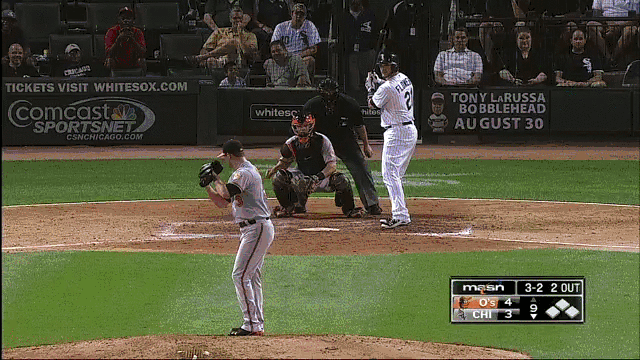What makes a dominant pitch dominant? Sometimes all we need is the eye test. That upper-90s heater elevated above the letters for a whiff? Yep, that is dominant. That mid-80s slider thrown down and away to a right-handed batter for a hapless swing and equally hapless chopper? No doubt, that’s nasty. Perhaps that late-breaking cutter, fading changeup, hammer curve or Hector Neris-esque splitter that delivers a routine popup for the infield? You know the drill.
Of course, in the saber-slanted era in which we currently find ourselves, we know there are other methods to determine what is (and what isn’t) a dominant pitch. Velocity aside, PITCHf/x data gives us insight into the precise movements of every pitch. And that’s certainly a key to a dominant pitch, right? Vertical drop, horizontal tilt, spin rate and perhaps even deception—though we don’t quite know how to quantify it, yet—are all required for a pitch to be considered, well, dominant.
Another thing that’s important: results. No, we’re not talking batting average or home runs allowed here. Those factors are important, but they are not as important as the underlying causes of those results, the pitch attributes. BIS President Ben Jedlovec wrote about the most dominant pitches in baseball for ESPN a few years back, and in his research, he used three attributes to evaluate an offering’s dominance: whiffs, groundballs and popups. I’m going to use the same criteria now to identify the most dominant pitches in 2016 this season.
Here are the details of my research. For whiffs, I’m using whiffs per swing. For groundballs, I’m using groundballs per batted ball. And for popups, I’m using popups per batted ball. In addition, I’ve set a minimum of 100 total pitches thrown through the games on Sunday, May 8, 2016, so qualifiers can be starters or relievers.
I’ve used z-scores to formulate pitch values for each of the three categories. Z-scores are a great way to measure a score’s relationship to the average in a set of data. A “0” z-score means that a pitch was equal to the mean; anything below zero means is was below-average, and anything above zero shows that the pitch was above-average, with “1” indicating that it was one standard deviation above (or below) the mean, and so on. So, each pitch here is assigned three z-scores. I then added them up to formulate what I’m going to call a “Dom-Score”, an abbreviated version of “Dominance Score.”
(All data courtesy Baseball Prospectus’ PITCHf/x Database)
[googleapps domain=”docs” dir=”spreadsheets/d/1V0T3gFJCB2f0J_8vJM4J1lf6QjluSDihoPIhFdX72bk/pubhtml” query=”widget=true&headers=false” width=”650″ height=”600″ /]
You’ll note that most of the top pitches by Dom-Score this season are thrown by relievers, particularly 4-seamers and 2-seamers. That’s not too much of a surprise given that fastballs and their velocities tend to play up for relievers in their shorter outings. Of course, Stephen Strasburg’s changeup gives those relievers a decent run for their money; his 3.27 Dom Score means his changeup is a whole three standard deviations above the mean changeup in our three categories. If you click on the “change” section of the table, you can see just how much of a gulf there is between Strasburg’s change and the next closest. Guess we know why the Nationals are extending him, huh?
Still, let’s not forget the leader, who quite clearly wields the best pitch in baseball this year: Zach Britton. Once again, not particularly surprising—it’s been good for a while. But you’ll notice that the offering absolutely excels in generating whiffs above the standard for 2-seamers; overall, opponents have missed on 42.6 percent of their swings against it this year. By comparison, the league-average 2-seamer in 2016 had generated misses at just a 13.8 percent clip entering play Monday night. Sinkers are typically thrown low in the zone for weak contact purposes, so the fact that it’s missing barrels at such a pace is nothing short of jaw-dropping. Let’s all enjoy it while its still here.
On the opposite end of the spectrum, we find Jered Weaver’s fastball. Shocked? I know I am. Seriously, though, perhaps it is a bit shocking to see Felix Hernandez’s curve in the cellar. We know his fastball has lost a tick or two early this season, but from the looks of it, the hammer has already lost about an inch of vertical movement from just two years ago. Similarly, it does look a bit ominous that Adam Wainwright has two pitches—his 2-seamer and curve—checking in at nearly -2 in Dom Score this year. Perhaps that’s partially to blame for his slow start?
We will continue to update this list throughout the season. Until then, though, we leave you with this Zach Britton sinker, doing what it does best:



